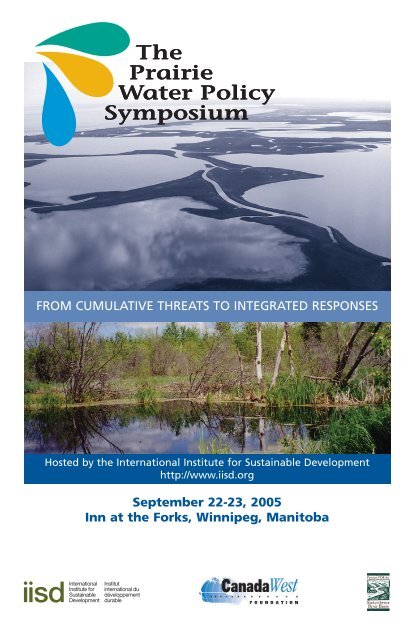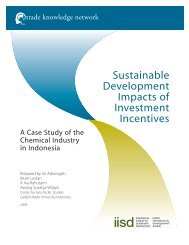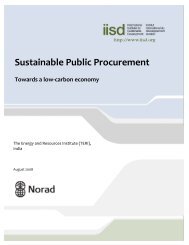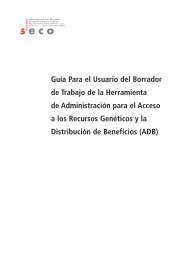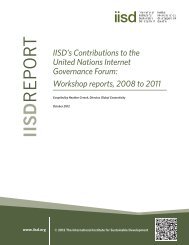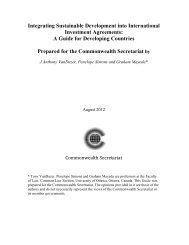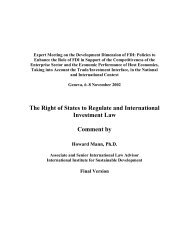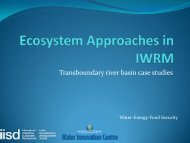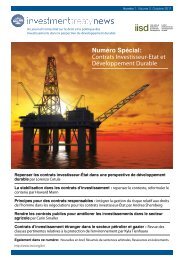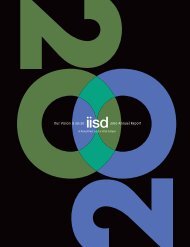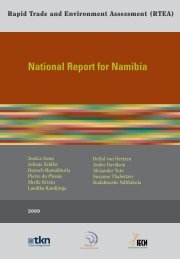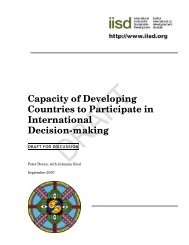Full program - International Institute for Sustainable Development
Full program - International Institute for Sustainable Development
Full program - International Institute for Sustainable Development
Create successful ePaper yourself
Turn your PDF publications into a flip-book with our unique Google optimized e-Paper software.
The<br />
Prairie<br />
Water Policy<br />
Symposium<br />
FROM CUMULATIVE THREATS TO INTEGRATED RESPONSES<br />
Hosted by the <strong>International</strong> <strong>Institute</strong> <strong>for</strong> <strong>Sustainable</strong> <strong>Development</strong><br />
http://www.iisd.org<br />
September 22-23, 2005<br />
Inn at the Forks, Winnipeg, Manitoba
Welcome to the Prairie<br />
On behalf of the Government of Canada, I thank the<br />
<strong>International</strong> <strong>Institute</strong> <strong>for</strong> <strong>Sustainable</strong> <strong>Development</strong> <strong>for</strong> organizing<br />
this Prairie Water Policy Symposium.<br />
Environment Canada is very pleased to both sponsor and participate<br />
in this symposium and I welcome IISD’s vast inter-provincial,<br />
and international experience in sustainable development issues.<br />
This experience is critical in contributing insights to the challenges<br />
and innovations that can guide the future policy framework <strong>for</strong> water management<br />
across prairie watersheds and elsewhere in Canada.<br />
The goal of clean, safe and secure water is universal, and not confined to any one geographic<br />
locale. It is through this kind of event that other watersheds can gain knowledge<br />
to achieve better integrated water management models.<br />
Participants should take this opportunity to offer their ideas on where the need <strong>for</strong><br />
progressive water policy is most acute.<br />
I also welcome the participation from provincial governments in outlining their<br />
respective water strategies, and look <strong>for</strong>ward to the results of the symposium.<br />
The Honourable Stéphane Dion<br />
Federal Minister of the Environment<br />
On behalf of the citizens and Government of Manitoba, it is my<br />
pleasure to welcome all participants to the Prairie Water Policy<br />
Symposium here in Winnipeg.<br />
Discussion of the use and management of fresh water in the prairie<br />
provinces is of the utmost importance at this time. Manitoba is<br />
rich with fresh water—the province has over 100,000 lakes alone.<br />
Nevertheless, diligence is required to ensure our fresh water is<br />
available <strong>for</strong> future generations. I would there<strong>for</strong>e like to commend<br />
the <strong>International</strong> <strong>Institute</strong> <strong>for</strong> <strong>Sustainable</strong> <strong>Development</strong> and sponsors <strong>for</strong> making this<br />
symposium a reality. The list of keynote speakers and participants is impressive and represents<br />
the finest expertise we have in the prairies. I am confident that the ideas and<br />
in<strong>for</strong>mation exchanged will be beneficial and constructive, with the ultimate goal of<br />
improving the prairies’ water sources.<br />
In closing, please accept my best wishes <strong>for</strong> a successful symposium.<br />
Gary Doer<br />
Premier of Manitoba
Water Policy Symposium<br />
On behalf of the City of Winnipeg, it is my pleasure to extend greetings<br />
to all those attending the Prairie Water Policy Symposium. We<br />
are honoured to be your hosts <strong>for</strong> what will undoubtedly be a great<br />
conference and I hope that our city will exceed all your expectations.<br />
This conference will provide you with the opportunity to discuss<br />
important issues with many national and international experts concerning<br />
sustainable development and water resource management.<br />
I would encourage each of you to take advantage of the networking opportunities<br />
with other industry professionals. I am certain that the educational sessions, in<strong>for</strong>mative<br />
speakers and social events will prove to be both enlightening and rewarding. It<br />
takes initiative, vision and hard work to make an event such as this happen and I<br />
would like to recognize the <strong>International</strong> <strong>Institute</strong> <strong>for</strong> <strong>Sustainable</strong> <strong>Development</strong> <strong>for</strong><br />
making this event possible.<br />
It is my hope that our visitors will experience the warm hospitality that our city offers<br />
and take the time to explore some of our city’s many attractions. Winnipeg is a vibrant<br />
young city that offers a variety of restaurants, great shopping and a host of cultural<br />
activities that I am sure you will enjoy. We truly have something <strong>for</strong> everyone.<br />
Once again, on behalf of my esteemed colleagues on city council, I would like to<br />
extend best wishes <strong>for</strong> a successful and rewarding conference.<br />
Sam Katz<br />
Mayor of Winnipeg<br />
Welcome to The Forks.<br />
Six thousand years ago, this was a great place to meet. It still is<br />
today.<br />
Located in the heart of the city, at the junction of the Red and<br />
Assiniboine Rivers, The Forks is an open and inviting expanse of<br />
riverside property where lush greenspaces mingle freely with<br />
unique shops, restaurants and entertainment.<br />
It is a site <strong>for</strong> all reasons, a place <strong>for</strong> all seasons: shopping at The Forks Market and<br />
Johnston Terminal, live theatre, a luxurious spa and hotel, a children’s museum, fine<br />
dining, quick service kiosks, stunning on-site attractions and non-stop entertainment.<br />
The Forks is the quintessential one-stop shop, feeding your body, mind and soul all<br />
in one beautiful setting. The Forks is a perfect destination <strong>for</strong> anyone who lives, works<br />
or plays in downtown Winnipeg, offering everyone something to love.<br />
You’re welcome.<br />
Bill Norrie<br />
Chair, The Forks North Portage Partnership
Welcome friends and colleagues to IISD’s Prairie Water Policy<br />
Symposium.<br />
Water is the staff of life. We know this, we feel this, we live this on<br />
the prairies. Our communities, our livelihoods, the prairie economy<br />
thrive or suffer with the vagaries of hydrology.<br />
Water connects societies with the ecosystems that sustain us in<br />
fundamental ways. Water quality is an immediate and fundamental<br />
indicator of ecosystem integrity, and our success—or lack thereof—at<br />
managing ecosystems sustainably. We can’t make it rain, but we can wisely use<br />
what we get. We reveal our commitment to future generations in our water consumption<br />
habits today.<br />
Do we manage our water resources as a precious ecosystem service? Should we? Will<br />
the cumulative threats to water resources on the prairies compel us to seek bold and<br />
inventive new ways to manage water?<br />
IISD is honoured to host you at this gathering of water policy experts at the <strong>for</strong>ks of<br />
the Red and Assiniboine Rivers—a meeting place and the hub of a vital transportation<br />
network <strong>for</strong> 6,000 years. We hope you feel a sense of community, collaboration<br />
and duty to future generations as we challenge ourselves and each other with these<br />
questions.<br />
Henry David Venema<br />
Director, <strong>Sustainable</strong> Natural Resources Management<br />
<strong>International</strong> <strong>Institute</strong> <strong>for</strong> <strong>Sustainable</strong> <strong>Development</strong><br />
A few words about the <strong>Sustainable</strong> Natural Resources<br />
Management Program at IISD<br />
IISD’s <strong>Sustainable</strong> Natural Resources Management <strong>program</strong> promotes the<br />
integration of policy, science and community as the key to Adaptive<br />
Management and increased resilience in Manitoba, Western Canada and<br />
around the world. IISD’s research in <strong>Sustainable</strong> Natural Resources<br />
Management bridges the gap between research and implementation through<br />
constant engagement with policy-makers and communities. Our litmus test<br />
<strong>for</strong> good policy is the community experience: are local ecosystems more<br />
resilient? Are livelihoods protected? Is the best available science being<br />
applied? Our challenge and our mission is to engage policy-makers and<br />
advance the policies and processes that ensure a positive answer to these<br />
questions.
Prairie Water Policy Symposium<br />
Partners<br />
The <strong>International</strong> <strong>Institute</strong> <strong>for</strong> <strong>Sustainable</strong> <strong>Development</strong><br />
The <strong>International</strong> <strong>Institute</strong> <strong>for</strong> <strong>Sustainable</strong> <strong>Development</strong> contributes to sustainable<br />
development by advancing policy recommendations on international trade and investment,<br />
economic policy, climate change, measurement and assessment, and natural<br />
resources management. Through the Internet, we report on international negotiations<br />
and share knowledge gained through collaborative projects with global partners,<br />
resulting in more rigorous research, capacity building in developing countries and better<br />
dialogue between North and South.<br />
IISD’s vision is better living <strong>for</strong> all—sustainably; its mission is to champion innovation,<br />
enabling societies to live sustainably. IISD is registered as a charitable organization<br />
in Canada and has 501(c)(3) status in the United States. IISD receives core operating<br />
support from the Government of Canada, provided through the Canadian<br />
<strong>International</strong> <strong>Development</strong> Agency (CIDA), the <strong>International</strong> <strong>Development</strong><br />
Research Centre (IDRC) and Environment Canada; and from the Province of<br />
Manitoba. The institute receives project funding from numerous governments inside<br />
and outside Canada, United Nations agencies, foundations and the private sector.<br />
Canada West Foundation<br />
The Canada West Foundation is an independent, non-partisan, non-profit public policy<br />
research institute dedicated to introducing western perspectives into current<br />
Canadian policy debates.<br />
Partners FOR the Saskatchewan River Basin<br />
Since 1993, Partners FOR the Saskatchewan River Basin has promoted stewardship<br />
and sustainability of the Saskatchewan River Basin. The Basin is an <strong>International</strong><br />
watershed stretching over the three Prairie Provinces and a portion of Montana. More<br />
than three million people live within the 420,000 sq. km Basin that includes the<br />
North Saskatchewan, Battle, Red Deer, Bow, Oldman, St. Mary, South Saskatchewan,<br />
Saskatchewan and Carrot Rivers.<br />
We uphold our mission “To promote watershed sustainability through awareness,<br />
linkages and stewardship” by:<br />
1 Developing public awareness and educational materials;<br />
2 Facilitating partnerships and networks; and<br />
3 Designing and implementing stewardship action projects.<br />
Partners FOR the Saskatchewan River Basin is comprised of a growing network of<br />
participating partner organizations. To date, there are over 100 active members and<br />
1,400 readers on our newsletter mailing list. We welcome you.
PRAIRIE WATER POLICY SYMPOSIUM<br />
Program at a Glance (subject to change)<br />
Main Ballroom (unless otherwise indicated)<br />
Inn at the Forks, Winnipeg, MB<br />
September 22-23, 2005<br />
All sessions held in plenary<br />
Wednesday, September 21, 2005<br />
7:00 p.m. Meet & Greet Reception and Registration<br />
to 8:30 p.m. Upstairs Foyer (Cash bar)<br />
Thursday, September 22, 2005<br />
8:00 a.m. Deluxe Continental Breakfast and Registration<br />
to 8:30 a.m. Upstairs Foyer<br />
Welcome<br />
8:30 a.m.<br />
to 9:00 a.m.<br />
Henry David Venema, Director, <strong>Sustainable</strong> Natural Resources<br />
Management, IISD<br />
Bill Glanville, Vice President and COO, IISD<br />
Paul Jordan, COO, Forks North Portage Partnership<br />
9:00 a.m. Morning Session – Biophysical Challenges<br />
to 12:30 p.m. Chair – Bill Rannie, Professor and Chair of Geography, University of<br />
Winnipeg<br />
Surface Water Challenges on the Canadian Prairies – Risk and Adaptation<br />
Dave Kiely, Manager, National Water Supply Expansion Program,<br />
AAFC-PFRA<br />
In<strong>for</strong>mation Systems Required to Ensure <strong>Sustainable</strong> Groundwater<br />
Supply<br />
Harvey Thorleifson, Director, Minnesota Geological Survey<br />
Urbanization: Physical Realities and Policy Trajectories<br />
Roger Gibbins, President and CEO, Canada West Foundation<br />
Nutrition Break (10:45 a.m. to 11:00 a.m.)<br />
Water Quality in the Lake Winnipeg Watershed<br />
Kevin Cash, Chief, Ecological Sciences Division, Environment Canada,<br />
Prairie and Northern Region<br />
Alberta’s Water <strong>for</strong> Life Strategy: Implications <strong>for</strong> the Oil and Gas<br />
Industry<br />
Sue Lowell, Director, Sustainability Strategy, Suncor Energy<br />
Geographical Analysis of Cumulative Threats to Prairie Water Resources<br />
Henry David Venema, Director, <strong>Sustainable</strong> Natural Resources<br />
Management, IISD<br />
12:30 p.m. to 1:30 p.m. Lunch Break<br />
1:30 p.m. Afternoon Session – Watershed Governance at Multiple Scales<br />
to 4:30 p.m. Chair – Ian Campbell, Senior Project Director, Policy Research Initiative<br />
A Prairie River: Challenges and Opportunities<br />
Susan Lamb, CEO, Meewasin Valley Authority<br />
Prairie Water Strategies: Innovations and Challenges in Strategic and<br />
Coordinated Action<br />
Darren Swanson, Project Manager, IISD
Indigenous Peoples and Watershed Management: A Discussion of<br />
Rights, Interests and Interesting Approaches<br />
Merrell-Ann Phare, Executive Director/Legal Counsel, Centre <strong>for</strong><br />
Indigenous Environmental Resources<br />
Nutrition Break (3:15 p.m. to 3:30 p.m.)<br />
Prairie Water Partnerships in Governance<br />
Phil Adkins, Acting Manager of Ag-Water Directorate, AAFC-PFRA<br />
Transboundary Watershed Governance: Experiences of the Red River<br />
Basin Commission<br />
Lance Yohe, Executive Director, Red River Basin Commission<br />
6:30 p.m. to 7:15 p.m. Evening Reception – Upstairs Foyer (Cash bar)<br />
7:15 p.m.<br />
to 9:00 p.m.<br />
Symposium Dinner<br />
Speakers – Terry Duguid and Norm Brandson, Co-Chairs, Lake Winnipeg<br />
Implementation Committee<br />
Friday, September 23, 2005<br />
8:00 a.m.<br />
Deluxe Continental Breakfast – Upstairs Foyer<br />
to 8:30 a.m.<br />
8:30 a.m. Morning Session – Integrating Best Practices<br />
to 12:00 p.m. Chair – Rick Findlay, Director, Water Programme, Pollution Probe<br />
Keynote Address<br />
Steve Ashton, Minister of Water Stewardship, Manitoba Government<br />
Saskatchewan Provincial Overview<br />
David Forbes, Minister of Environment, Saskatchewan Government<br />
Alberta Provincial Overview<br />
Beverly Yee, Assistant Deputy Minister, Alberta Environment<br />
Nutrition Break (10:15 a.m. to 10:30 a.m.)<br />
Watershed Evaluation of Beneficial Management Practices Across Canada<br />
Brook Harker, Manager, WEBs Project, AAFC-PFRA<br />
Environmentally <strong>Sustainable</strong> Agriculture and Water Quality:<br />
A Tri-National Collaborative Initiative<br />
Tim Marta, Associate Director, AAFC-Agri-Environmental Policy Bureau<br />
Best Practices: Australia<br />
Jim Robinson, Associate Professor, University of Waterloo<br />
12:00 p.m.<br />
to 1:00 p.m.<br />
1:00 p.m.<br />
to 4:00 p.m.<br />
Lunch Break<br />
Speaker – The Honourable Lloyd Axworthy, President of the University of<br />
Winnipeg and <strong>for</strong>mer Minister of Foreign Affairs<br />
Policy Discussions – Critical Policy Innovations and Gaps<br />
Facilitators – Henry David Venema and Stephan Barg, Senior Corporate<br />
Advisor, IISD<br />
Nutrition Break (2:30 p.m. to 2:45 p.m.)
Presenters’ Abstracts<br />
Phil Adkins<br />
Acting Manager of Ag-Water Directorate, AAFC-PRFA<br />
Prairie Water Partnerships in Governance<br />
The governance of water on the prairies is driven by necessity in the semi-arid agricultural regions<br />
where the human population places high demands on a limited resource. The Prairie Farm<br />
Rehabilitation Administration (PFRA), as a federal agency with prairie regional responsibilities,<br />
has worked in partnership with the three prairie provinces, in a non-regulatory resource<br />
care/developmental role since 1935. One of the highlights of water governance on the prairies is<br />
the Prairie Provinces Water Board (PPWB) which was established in 1948. The Board is made<br />
up of representatives from each province, Environment Canada and PFRA.<br />
There is a gap in our institutional framework to address the strong interdependence between<br />
water and agriculture. Employing the principles of Integrated Water Resource Management will<br />
help address this gap, and be important to overall prairie water governance, as we adapt to increasing<br />
climate variability and its affects.<br />
Kevin Cash<br />
Chief, Ecological Sciences Division, Environment Canada, Prairie and Northern Region<br />
Water Quality in the Lake Winnipeg Watershed<br />
The Lake Winnipeg watershed is faced with a vast array of environmental issues including water<br />
availability (too much and too little); water quality; habitat fragmentation; wildlife and habitat<br />
loss (e.g., wetlands and uplands); invasive species; wildlife disease; genetic pollution; degraded<br />
freshwater fisheries and fish habitat; municipal water and urban sprawl; climate change; and flow<br />
regulation. The federal government has a wide variety of interests that relate to the long-term sustainability<br />
of the water resources within the inter-jurisdictional Lake Winnipeg Watershed and of<br />
Lake Winnipeg. Actions are required to restore Lake Winnipeg whilst providing economic opportunities<br />
and social benefits without compromising the sustainability of vital ecosystems. It also<br />
acknowledges that sound knowledge about the watershed resources and ecological processes is a<br />
pre-requisite to sound decision-making. This presentation will describe Environment Canada’s<br />
current water quality <strong>program</strong> within the basin and will briefly outline a proposed path <strong>for</strong>ward<br />
to provide the science understanding required <strong>for</strong> effective management of this system.<br />
Roger Gibbins<br />
President and CEO, Canada West Foundation<br />
Urbanization: Physical Realities and Policy Trajectories<br />
Urbanization is both an established feature of, and an unrelenting trend on, the prairie landscape.<br />
At the same time, potential water shortages are a growing trend across the prairie west. However,<br />
the relationship between urbanization and looming water shortages is complex. For the most part,<br />
cities are efficient consumers of water, and thus the impact of urbanization on water shortages may<br />
be less than the impact of water shortages on urbanization. In the short term, the greatest impact<br />
of urbanization may come from their growing demographic and political clout; the impact of what<br />
we do in the cities with respect to water conservation may have less to do with the physical realities<br />
of water shortages than it will with respect to the public policy frameworks through which we<br />
will address more contentious and problematic water issues.
Brook Harker<br />
Manager, WEBs Project, AAFC-PRFA<br />
Watershed Evaluation of Beneficial Management Practices Across Canada<br />
The WEBs project is an AAFC-led initiative that seeks to quantify at a micro-watershed scale<br />
(~300ha), the relative environmental and economic per<strong>for</strong>mance of site-specific “Beneficial<br />
Management Practices” (BMPs), at seven regional locations across Canada. The four-year study is<br />
geared to facilitate multi-agency involvement and cooperation within WEBs project sites. In this<br />
discussion we will first undertake a brief overview of the scope of the project (nationally and regionally),<br />
then focus on linkages to other APF <strong>program</strong>s such as NAHARP, NALS, NLWIS and<br />
Census/FEMs; as well as our relationship to companion studies such as the Conservation Effects<br />
Assessment Program (CEAP) within the USDA. We will also examine how WEBs results might be<br />
transferable to ag policy and on-farm applications through an integrated modelling process.<br />
Dave Kiely<br />
Manager, National Water Supply Expansion Program, AAFC-PRFA<br />
Surface Water Challenges on the Canadian Prairies – Risk and Adaptation<br />
The Canadian prairies have a long history of adapting and coping with water supply challenges.<br />
The prairies are a region that experiences recurrent drought due to climate limitations.<br />
Hydrologic drought has <strong>for</strong>ced adaptation and structural solutions in the past. Economic and<br />
social factors are becoming more important as surface water supplies are becoming more precious.<br />
Experience gained from coping with current climate variability should be harnessed to address<br />
future adaptation to climate change/climate variability.<br />
Susan Lamb<br />
CEO, Meewasin Valley Authority<br />
A Prairie River: Challenges and Opportunities<br />
Meewasin is a conservation agency responsible <strong>for</strong> about 80 km of South Saskatchewan River valley<br />
in and around Saskatoon and the R.M. of Corman Park. A partnership of the City of<br />
Saskatoon, the Province of Saskatchewan and the University of Saskatchewan, we provide stewardship<br />
of this important riverine resource.<br />
Meewasin has a 100-year plan that provides guidance as we make decisions about conserving,<br />
developing and educating people about the valley. Our projects range from using sheep to manage<br />
grassland, to providing interpretive <strong>program</strong>s <strong>for</strong> children, to a multi-million dollar redevelopment<br />
of the riverfront in downtown Saskatoon. Meewasin manages the Partners FOR the Saskatchewan<br />
River Basin, a stewardship organization <strong>for</strong> the Saskatchewan River basin from its origins in the<br />
Rockies to its final destination in Hudson Bay.<br />
Sue Lowell, Director<br />
Sustainability Strategy, Suncor Energy<br />
Alberta’s Water <strong>for</strong> Life Strategy: Implications <strong>for</strong> the Oil and Gas Industry<br />
Water is an important resource in the Province of Alberta. The provincial government is implementing<br />
its Water <strong>for</strong> Life Strategy which identified three key directions—knowledge and<br />
research, partnerships and water conservation. This presentation will elaborate on how the strategy<br />
affects the oil and gas industry, and show what roles the industry must play to continue its<br />
growth and development.
Tim Marta<br />
Associate Director, AAFC-Agri-Environmental Policy Bureau<br />
Environmentally <strong>Sustainable</strong> Agriculture and Water Quality: A Tri-National Collaborative<br />
Initiative<br />
The Tri-National Collaborative Initiative on Environmentally <strong>Sustainable</strong> Agriculture and Water<br />
Quality originated from an in<strong>for</strong>mal agreement between the Deputy Minister <strong>for</strong> Agriculture and<br />
Agri-Food Canada and his counterparts from Mexico and the United States of America to hold<br />
a Tri-National Workshop, in Canada, in October 2003. Three Tri-National Working Groups<br />
were established to collaborate in the areas of Policy Instruments, Program Delivery (focused on<br />
Beneficial Management Practices), and Research and In<strong>for</strong>mation relative to environmentally<br />
sustainable agriculture and water quality. The work consists of sharing national in<strong>for</strong>mation and<br />
conducting tri-national analysis <strong>for</strong> the three subject areas. The presentation will review the development,<br />
processes, mechanisms and expected results of the Initiative.<br />
Merrell-Ann Phare<br />
Executive Director/Legal Counsel, Centre <strong>for</strong> Indigenous Environmental Resources<br />
Indigenous Peoples and Watershed Management: A Discussion of Rights, Interests and<br />
Interesting Approaches<br />
Effective and meaningful governance of watersheds involves numerous jurisdictions and their<br />
decision-makers, including Indigenous peoples and their governing structures. Achieving cooperation<br />
between these jurisdictions is often confounded by the evolving state of recognition of<br />
Indigenous governance rights, the relative lack of environment-related Indigenous governance<br />
institutions and lack of consensus among watershed governance participants as to the long-term<br />
vision <strong>for</strong> the watershed. This presentation will outline key challenges faced by Indigenous peoples<br />
when participating in watershed governance, including policy voids that hinder their involvement,<br />
and will suggest possibilities <strong>for</strong> future cooperative ef<strong>for</strong>t.<br />
Jim Robinson, Associate Professor, University of Waterloo<br />
Best Practices: Australia<br />
Australia, the driest inhabited continent, has been experiencing more severe droughts than anticipated<br />
based on historical records. Towns and cities all have supply reservoirs that are completely<br />
dry or are at lower levels than ever experienced. The policy and <strong>program</strong> approaches and responses<br />
to this are varied. Melbourne has been quite proactive in developing a Water Resources Strategy<br />
that effectively provides <strong>for</strong> significant population growth supported by water use reductions by<br />
existing customers. Other areas are considering supply options that can be developed to meet or<br />
stave off the crisis. A selection of cases and their anticipated resolution will be discussed, along<br />
with suggestions of lessons we might learn.<br />
Darren Swanson<br />
Project Manager, <strong>International</strong> <strong>Institute</strong> <strong>for</strong> <strong>Sustainable</strong> <strong>Development</strong><br />
Prairie Water Strategies: Innovations and Challenges in Strategic and Coordinated Action<br />
Alberta, Saskatchewan and Manitoba have each articulated a water resources management strategy<br />
to help address challenges within their provincial jurisdiction. Additionally, the inter-provincial<br />
allocation of water is being managed through the Prairie Provinces Water Board, a federalprovincial<br />
partnership. Other individual watershed groups are also playing local and regional<br />
planning and management roles.<br />
Each jurisdiction is currently grappling with the inherent challenges of this process including leadership,<br />
planning, implementation, monitoring, learning and adapting, multi-level coordination<br />
and participation. This synthesis report provides an in depth study of the common challenges and<br />
innovations in these aspects of water management and the findings constitute a pragmatic toolbox.
Harvey Thorleifson<br />
Director, Minnesota Geological Survey<br />
In<strong>for</strong>mation Systems Required to Ensure <strong>Sustainable</strong> Groundwater Supply<br />
Surface water and groundwater systems are linked, and both human and ecosystem well-being are<br />
dependent on the quantity and quality of this hydrological cycle. Groundwater is the key water<br />
source <strong>for</strong> drinking water and irrigation—it is our only usable freshwater reserve, and it sustains wetlands<br />
and stream flow. We currently are striving to ensure that our groundwater usage is sustainable<br />
which requires sustainable pumping rates, maintenance of water quality, preservation of aquatic<br />
environments and integrated surface/groundwater management. Mapping of soils, geology, and<br />
groundwater systems in 3D is required to guide groundwater protection, monitoring, and management.<br />
Geological mapping there<strong>for</strong>e is rapidly shifting from the production of paper maps to construction<br />
of digital, interactive, 3D models that more fully characterize relevant material properties<br />
and provide insights into the capacity and vulnerability of regional groundwater systems.<br />
Henry David Venema<br />
Director, <strong>Sustainable</strong> Natural Resources Management, <strong>International</strong> <strong>Institute</strong> <strong>for</strong> <strong>Sustainable</strong><br />
<strong>Development</strong><br />
Geographical Analysis of Cumulative Threats to Prairie Water Resources<br />
The objective of this study is to gain an integrated perspective on water quality and quantity vulnerabilities<br />
across the Canadian prairie provinces. We use environmental indicator methods and<br />
GIS techniques to rank and map water quality, water use, and water availability and their compounding<br />
effects across the prairie agro-region. A composite index identifies “hotspot” areas of<br />
concern with high cumulative stresses. We then compare the hotspot analysis with parallel geographic<br />
analyses of water conservation practice, and water conservation policies to illustrate where<br />
integrated water resources management will be a policy priority.<br />
Lance Yohe<br />
Executive Director, Red River Basin Commission<br />
Transboundary Watershed Governance: Experiences of the Red River Basin Commission<br />
The Red River Basin is a unique geographic area drained by the Red River of the North flowing<br />
from the United States into Canada. Multiple state and provincial boundaries as well as the international<br />
boundary create complexities <strong>for</strong> basin watershed strategies.<br />
There have been numerous ef<strong>for</strong>ts to address transboundary watershed governance issues in the<br />
Red River Basin. Some ef<strong>for</strong>ts have been within the framework of the two countries and other<br />
ef<strong>for</strong>ts have focused on the transboundary international issues.<br />
Working across all of the boundaries is essential to develop and implement a Red River Basin<br />
vision <strong>for</strong> the future. The Red River Basin Commission (RRBC) has been <strong>for</strong>med to work cooperatively<br />
across all of the boundaries with all levels of government. The RRBC Mission is to create<br />
a comprehensive integrated basin-wide vision; to build consensus and commitment to the<br />
vision; and to speak with a unified voice <strong>for</strong> the Red River Basin.<br />
To accomplish this mission, the RRBC has developed a Red River Basin (RRB) Natural Resource<br />
Framework Plan (NRFP). The NRFP has 13 basin-wide goals that become real in the “Action<br />
Agenda” where activities in the basin become the tools that help achieve the vision. In the RRBC<br />
experience, governance becomes a function of those who are doing things today and success a<br />
function of everyone working to achieve the same overall goals <strong>for</strong> the benefit of this and the next<br />
generation.
The <strong>International</strong> <strong>Institute</strong> <strong>for</strong> <strong>Sustainable</strong> <strong>Development</strong>, the<br />
Canada West Foundation and Partners FOR the Saskatchewan<br />
River Basin thank the following funders of the Prairie Water<br />
Policy Symposium. We are grateful <strong>for</strong> their support.<br />
For symposium proceedings and outputs, see<br />
http://www.iisd.org/natres/water/pwps.asp


